John Wayne in Lone Pine

Lone Pine could provide what the small studios could not: production value. The trip north was worth the trouble because they would get the snow-capped Sierra Nevada Mountains – free of charge. They found all the western scenery just two miles west of Lone Pine, in the Alabama Hills. John Wayne first came to this rock-studded splendor in 1933 for Somewhere in Sonora.

In 1935, Republic contract player John Wayne stayed at the Dow’s, as it was called then, for the first time. Originally, the hotel at 310 S Main St had fifty-five rooms. In one of them, Glenn Ford and Rita Hayworth were having an affair in 1948, during the making ofThe Loves of Carmen.

The living room at the Dow Villa, filled with memorabilia, including a nice snapshot that shows John Wayne with the house keeper.
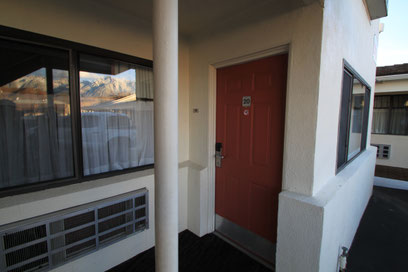
In 1957, the Dow’s was changed to the Dow Villa and the first motel units were added. During his last visits to Lone Pine, Wayne preferred to stay in Motel Room 20.

Turn onto Whitney Portal Road at the only stoplight in town. If you follow the road all the way through, it’ll take you up to the Whitney Portal area. When mountain man Henry Fonda built his cabin up there in How the West Was Won, it was still called Hunter’s Flats. It is now a quiet camping area, 4,000 feet high above Lone Pine.

After Somewhere in Sonora, the young star was sent back to the the area in 1934, for Blue Steel, filmed in the Big Pines section. The Man From Utah was in production between the end of March to April 3, 1934. Lawless Range was simultaneously filmed in those brown, orange and graycolored rocks, from May 19 to June 3. The New Frontier was there for some shots, too, in August 1935.
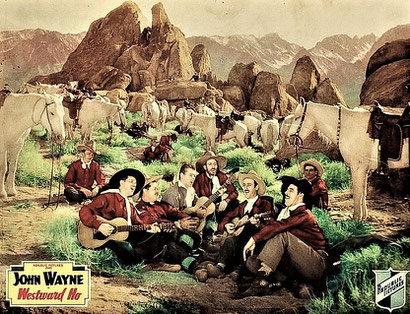
Westward Ho was shot from May 19 to June 3, 1935. If you turn left on Horseshoe Meadow, there is a distinctive formation of rocks on the left. The evil temple of Kali in the classic Gunga Din stood in the same place.
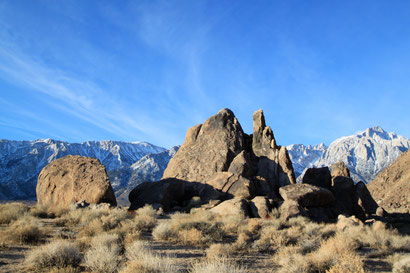
Same place, 85 years later: This is where Wayne and his Singing Riders captured the outlaw gang in Westward Ho. Wayne also strung a rope across the trail to tripp some riders following him in The PotSa-Ga-Wa Gardens (so-called from the days when Paiute Indians from the local Reservation put on ceremonial dances).

John Wayne and his Singin' Riders passed this distinctive rock...

..on Horseshoe Meadow Road, in Westward Ho!

This narrow canyon, close to the place which is marked on maps as "The Lone Ranger Canyon", is where John Wayne gets ambushed in Westward Ho! Yak Canutt stages some nice falls, so Wayne could shoot down the ambushers.
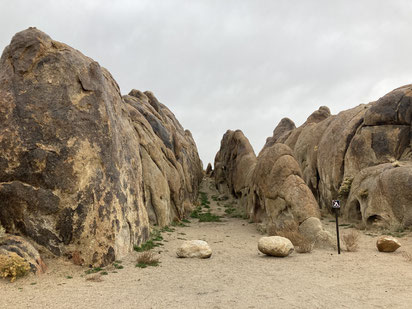
When he returned for King of the Pecos, one year later, they used that same canyon as a location for a little cat and mouse game with the baddie before the final showdown (Tarantino used the same location for a campfire scene in Django Unchained).

Two more Lone Pine movies were on his 1936 schedule: The Lawless Nineties, January 12 to January 21, and King of the Pecos, February 5 to February 11. As you come up from Lone Pine, turn right to the Alabama Hills at the intersection, which is marked by a white rock with a plaque. This will put you onto Movie Road. They called it so because it has the flattest terrain for shots of riders galloping and because it was so smooth, they could let the star do his own riding in traveling shots. Locals still call this whole area Movie Flats. There’s a narrow road twisting through the rocks on the east side of Movie Road, called the Lone Ranger Canyon. It’s also the place where Wayne shot it out with his parents’ murderer at the end of King of the Pecos.

Just a short walk from Lone Ranger Canyon, where the trail forks, is the distinctive rock that marks the location of the badmen in King of the Pecos. In this picture, John Wayne is seen about to take out that fence with his rope.

The location of King of the Pecos, where John Wayne traded shots with the bad guys, is unchanged as of today. The fence led across the dirt road. On that same road, not far from here, the remains of a stone wall which was erected for a war movie are still visible.
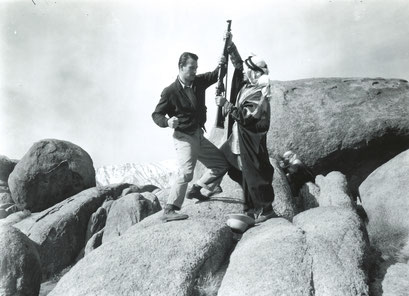
When John Wayne returned the following year, in 1937, the Universal picture I Cover the War used the very same area that had seen action in King of the Pecos. The Alabama Hills doubled for rugged Middle Eastern terrain. Imported palm trees helped sustain the illusion that Wayne was acting in the middle of the Arabian Desert....

...which is actually the same area filmed in before in King of the Pecos. This time, the Alabama Hills stood in for the Middle-East.

Yakima Canutt ambushes the Wayne family in the first reel of Westward Ho. The lobby card shows the flat area often used for desert scenes...
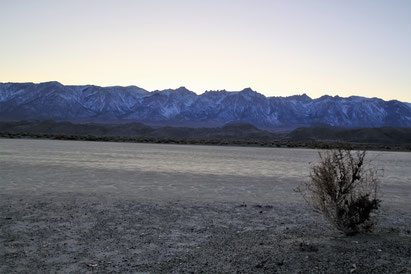
...which was actually located north of town and seldom found by location hunters, called simply the playa.
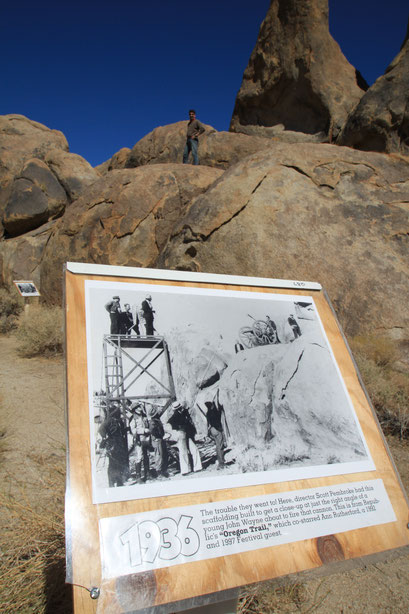
They squeezed in The Oregon Trail just before Christmas, between December 14 and 23. This is the one John Wayne film that must be considered lost forever. Shown here is the boulder on which Wayne mans a cannon.

He was back in the Alabama Hills for Three Faces West, made in 1940, March 27 to April 16. This rare production shot, courtesy of the Museum of Western Film History in Lone Pine, shows the "Okie Caravan".

Tycoon was Wayne’s biggest Lone Pine picture, in production between January 6 and April 26. At first, RKO had intended to shoot it at its new studio in Churubusco, Mexico. Shortly before the start of production, plans were changed.
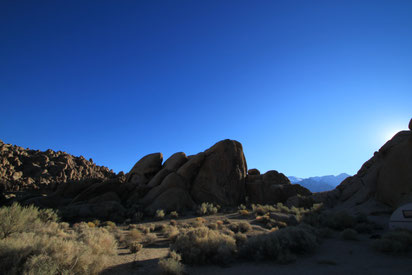
As you come up from Lone Pine towards the Alabama Hills, that’s the first John Wayne location you’ll see to your right. The Tycoon tunnel entrance was a fake facade built between the two massive outcroppings in the Ruiz Hills area so that Wayne, as the construction engineer, could blow a tunnel through it.

Since this John Wayne movie went down in the books as a dud, the excellent production artwork went largely unnoticed, even though the production designers Carrol Clark and Albert S. D'Agostino had a number of Hollywood classics to their credit, amont them King Kong, Mary Poppins, and The Thing. The impressive camp of the construction crew was built onsite, most notably...

...the tunnel itself, that seems to be John Wayne's main antagonist: it was realistically built with plaster, and the full front was hanged between the two outcroppings in the Alabama Hills. To this day - 75+ years after the filming of Tycoon - you'll still find the iron girders to both sides of the tunnel entrance that held the construction up.

The tunnel entrance actually had a certain length, to combine studio sets of the tunnel with shots filmed towards the real background of the Alabama Hills.

The exact same angle today, from which the above shot was taken, filming from the "inside" of the tunnel. The road we are standing on is actually a dead end, bulldozed by the Tycoon production crew, to give the impression that John Wayne can drive a railroad car in- and out of the fake tunnel.

John Wayne is confronting claim jumpers with a runaway wagon in North to Alaska: this action sequence brought him back for his last Lone Pine movie in 1960 when director Henry Hathaway chose...

...the area on the left to the Whitney Portal Road, at these gravelly slopes. The resulting mud fight in the Lone Pine Creek was shot where Lone Pine Campground is now. The snow-capped Sierra Nevada Mountains helped to give the audience a Yukon feeling.
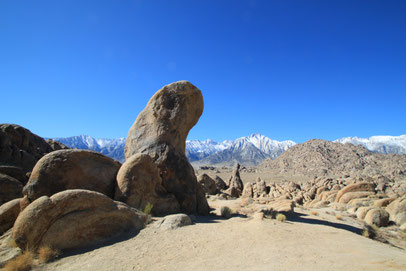
The rock-studded splendor of the Alabama Hills: This bulky rock marked the start of the Indian chase in How the West Was Won (1963).

It was on Movie Road that John Wayne rode into the sunset for the last time. On August 25, 1978, he did the Great Western Savings commercial. Wayne came a day early to pick the locations himself. He rented a vehicle at the local car dealer to go off-road. But as he got the truck stuck in the sand, he had to hitchhike back to town. This visit to Lone Pine also marked his last stay at the Dow’s.
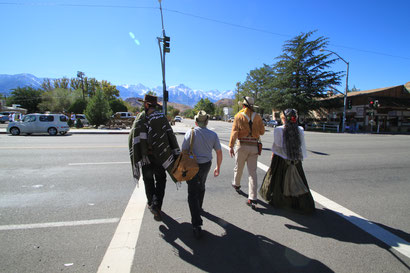
The annual Lone Pine Movie Festival brings back some of the stalwarts to reminiscence. The festival held every October on Columbus Day weekend is highly recommended.

The Lone Pine Film History Museum at 701 S Main St features features great movie artifacts and some fine Wayne mementos, too. Right outside the museum stands the chuck wagon from The Cowboys.
Keeler
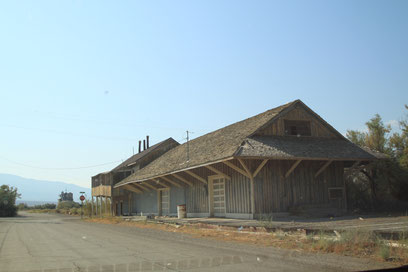
CA-136 that runs along the northern edge of Owens Lake will lead you from Lone Pine to the semi-ghost town of Keeler. That’s where John Ford shot the railroad scenes for Three Godfathers. The Carson & Colorado Railroad narrow gauge line...

...was discontinued to Keeler in 1960. The depot remains intact although not in use and falling into disrepair. The Apache Wells Depot with its water tower was built for Three Godfathers as a set.
©All text content on this website is protected by copyright and other intellectual property laws. No part may be reproduced without the prior written permission. All photos courtesy of Roland Schaefli, unless otherwise stated.
This website is in no way associated with the John Wayne Estate or business enterprises. Go to johnwayne.com to find the official website and to https://johnwayne.org/ to read about the wonderful John Wayne Cancer Foundation.
more john wayne locations to scout
If you like this site, you'll like the book: the first comprehensive guide to the John Wayne Locations, with hundreds of then-and-now photos, unpublished behind-the-scenes-pictures and detailed tour descriptions
Tracking John Wayne: The complete Tourguide
Find directions to locations and anecdotes from the Duke's movie sets in this new publication from McFarland, available at bookstores and online shops
For all locations mentioned on this website, the book offers behind-the-scenes stories, making-of anecdotes and never before published photos

